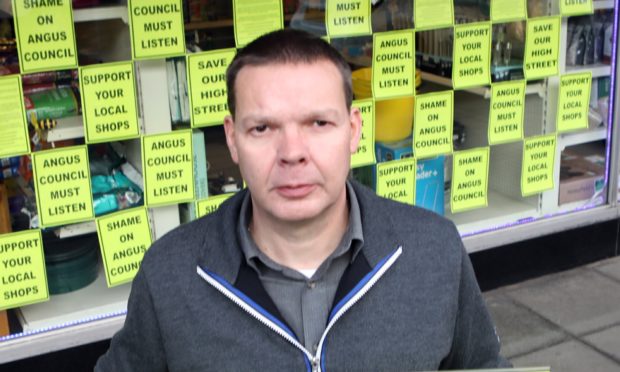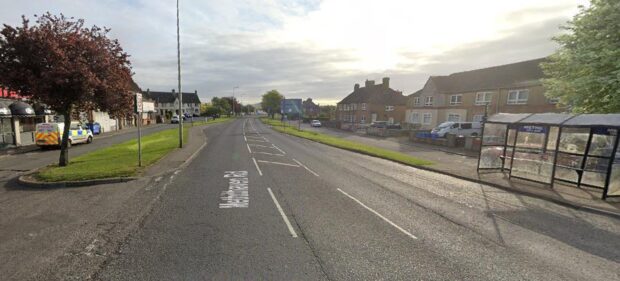Angus and Fife town centres are among those worst hit by the “blight” of shops lying empty and unused, according to a report.
Angus, Fife and Dundee City are all among the seven council areas in Scotland with more vacant retail properties than the national average of one in ten.
The Federation of Small Businesses (FSB) paper Transforming Towns reveals Angus is hardest hit, with 15% of shops lying empty and unlet, closely followed by Fife and Dundee City.
The report reveals town centres across the region are reeling from waves of closures, with at least 54 recorded since 2016.
The FSB is calling for a raft of measures to bolster town centres, including £90 million per year in new investment, a government commission to investigate “the blight” of vacant shops and for banks to set up shared hubs.
Angus has already been allocated £1.08m and Fife £4.35m from the Scottish Government’s £50m Town Centre Fund for 2019/2020.
Andrew McRae, FSB’s Scotland policy chair, said: “More people in Scotland live in towns than cities. That’s why government must make a generational investment in our towns to overcome their current challenges.”
He said investment should come from the Scottish National Investment Bank and the UK government’s Stronger Towns Fund.
“After the wave of recent closures, we need to rethink how we use our high streets. A new commission should investigate the barriers to bringing vacant properties back into use, even if that means turning offices into housing, or department stores into art galleries.
“We need to make it cheap and easy for independent businesses to take up high street property.”
Bruce Robertson, Angus Business and Retailers Association, welcomed the report, but said action is required now to stop the situation from sliding further.
“It is encouraging. But it is all very well talking about what is possible when little action seems to come from it.”
He said he was not surprised the number of empty shops in Angus is among the highest in Scotland.
“It’s a big number, but it is no wonder. There is no encouragement for investment in Angus. At the moment, I wouldn’t invest in Angus retail.”
Vicky Gunn, owner of Millie’s Pet Services in Carnoustie, said she has mixed feelings about the challenges facing local businesses.
She will shortly expand her grooming business into the building vacated when the town’s Bank of Scotland branch closed.
She said: “On one hand it’s given us room to expand, but on the other it’s painful. With opening hours, I have to travel to Arbroath or Broughty Ferry to do my banking as many customers prefer to use cash.”
She said business owners should work more closely together to protect town centres and high streets.
“Just standing in the front of my shop, I can see three empty units from here. We are all fighting for ourselves, when the message should be about bringing people together to see where we can support each other.”
An Angus Council spokesman said they will take time to consider the contents of the report.
“Kirkcaldy needed help yesterday”
Kirkcaldy4All manager Bill Harvey is under no illusions about the challenges facing the Fife town.
“Kirkcaldy needed help yesterday,” he said.
The town has been as badly hit as any in Scotland by closing shops and falling footfall.
The Federation of Small Businesses report points to the upcoming closure of Debenhams while at least six bank branches, shops and local premises closures have been announced since the start of 2016, it says.
Other big retailers such as BHS and M&S are among them.
Mr Harvey, whose group works to promote growth across the district, said some of the actions in the report may be too little, too late.
He said: “We have had review after review dealing with things like this. By the time a commission reports back, and action is taken, we might by five or six years behind the line. Some town centres will have gone by then.”
He welcomed the call for targeted investment from the Scottish National Investment Bank and the UK Stronger Towns Fund, but said key decisions on how it was spent must be made on the grounds of what local businesses need.
“We are often constrained on spending it on capital projects, when sometimes other things would deliver a better result.”
“Any investment is good investment, but it has to be flexible,” he added.
Janet Torley, FSB’s East of Scotland area leader, said: “Almost 50,000 people call Kirkcaldy their home. But towns like this have recently faced real pressure from big business and public sector closures.
She said the closures of big name stores in the high street, combined with the growth of Kirkcaldy’s out of town retail parks and the collapse of major employers such as Havelock, have created major challenges.
“Sustained and strategic investment will be needed to turn around the fortunes of Kirkcaldy and other similar Scottish towns,” she added.
Fife Council co-leader, councillor David Ross, Labour, welcomed the report. “We’re committed to investment plans for our town centres to help create thriving places all around Fife,” he said










